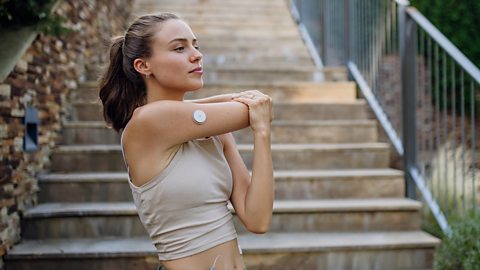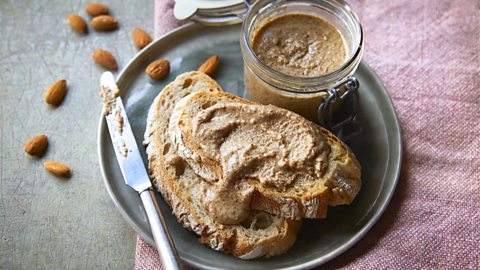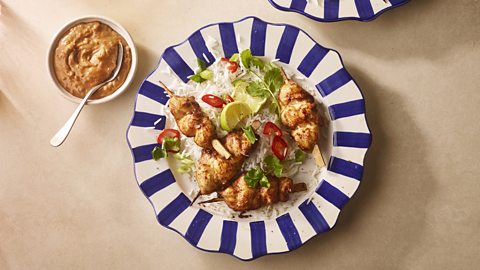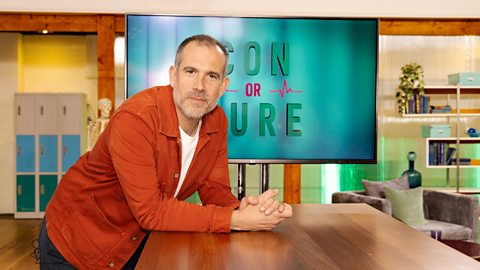Will a glucose monitor help you be healthier?
The trend for continuous glucose monitoring (CGM) at home is growing as people tap into the personalised diet movement seen on social media. But can they help you to be healthier? We ask the experts…

The science behind CGM is invaluable for people with type 1 diabetes, and looks promising for nutritional purposes. The theory is that by knowing what foods your body best responds to, you can adjust your diet to support good health and even lose weight. But do they really provide a great dietary solution?
Trigger warning: Please note, there is mention of disordered eating in the below article
What are continuous glucose monitors?
“Commonly used for people with type 1 diabetes, glucose monitors are little sensors which attach to your arm or tummy and measure how much glucose is in the fluid under your skin. You can then see via a reader or an app what your blood sugar levels are. You see patterns emerge over days and weeks,” explains dietitian Priya Tew.
“By tracking this data, people with diabetes can see how their body responds to different foods and how much medicine – such as insulin they might require.”
However, over the last few years, people without diabetes have started to use the gadgets to influence their nutrition and diet.
How might continuous glucose monitors improve health?
“Our responses to food can vary from person-to-person,” explains Tew. “So, if two people both ate a piece of bread, they’d have a slight variation in their [blood sugar] responses. By monitoring how you respond to different foods, you’ll know what’s more likely to cause spikes in your glucose levels.”
In theory, following a diet that avoids large blood sugar spikes means the body is less likely to store the excess glucose (sugar) produced as fat. A more even glucose response allows the body to use that energy for growth and repair instead.
Because people will be monitoring their food intake, they are likely to be more aware of what they’re eating and therefore more likely to stick to a healthier diet.
While the research is in its infancy, there’s evidence CGM may be effective for improving diets, says Dr Alaina Vidmar, a pediatric endocrinologist, obesity medicine specialist and the medical director of the Healthy Weight Clinic at Children’s Hospital Los Angeles.
As part of a team, Vidmar conducted two studies to see if there’s evidence CGM could help with obesity. “Both studies showed CGM is a well-tolerated and versatile tool for both obesity research and clinical practice in pediatric and adult patients but,” Vidmar warns, “there is overall very little research on this topic to date.”
Related stories
What does CGM data really tell you?
“While they have benefits, CGMs come with big drawbacks,” says Tew.
“The information you then get fed back is often not from healthcare professionals. You haven't got somebody going through and interpreting results. So yes, you've got a report, but it can be difficult to interpret.
“If an electrician was to give me a summary of my house. I might have that report, but I wouldn't really know what to do with it. The same applies here.
“In my clinical practice, people are turning up with their reports and saying ‘Well, I can't eat any of these foods because they give me a big spike in my blood sugars’. We shouldn’t be encouraging people to cut foods unnecessarily, diversity is so good for our gut health.
“I think it's really worrying that people are cutting foods out without fully understanding data,” says Tew.
What can influence your glucose readings?
While CGM is a useful tool, the results can be tricky to interpret because other variables can impact your glucose readings, these include:
Physical activity
“If we do vigorous exercise one day, it can still influence our blood sugars into the following couple of days. It is this very reason that type 1 diabetics find it so difficult to manage their blood sugars when exercising because they could actually have a hypo almost 12 hours later related to the exercise activity. This is where glucose monitoring and these CGM have been so useful, helping type 1 diabetics, especially those that are physically very active,” explains Sports dietitian Renee McGregor.
Hormones
“For women, when we are in the luteal phase of our menstrual cycle, post ovulation and when oestrogen and progesterone tend to be more dominant. This has a huge impact on our blood sugars and often this is why women find their mood being so irrational, as their blood sugars fluctuate significantly,” says McGregor.
Stress
“Stress has a huge part to play in blood sugars. We have to remember that when our body experiences stress, it is setting up for fight, flight, freeze and so blood glucose can rise in response to adrenalin. Similarly, when we have high cortisol levels, this can influence our blood sugars,” McGregor adds.
Food combining
“If you get a blood sugar spike after eating a slice of bread, that doesn’t mean you should then cut it out of your diet. If you put some peanut butter on the bread it’s going to blunt the response, you’re not going to have that high blood sugar level,” says Tew.
“Even what we eat can create a different response each time we eat it and experts really don’t know why this is the case,” explains McGregor. “This is also why it’s not as simple as if you eat x your blood sugar will rise, because sometimes it will and sometimes it won’t or it will but not be as marked a rise.”
Balanced meals to get your five-a-day
Almond butter
If you get a spike after eating bread, it could be lessened by adding a nut butter to the top

Could glucose monitoring be triggering for vulnerable patients?
“I am an eating disorder dietitian,” says Tew. “I've been seeing an issue in clinic with people who are highly vulnerable. They’re on a meal plan that we’ve been working on together, but they’ll come to appointments and say ‘I've been told that based on my blood sugars I can't eat any of these foods’. I’m having to provide education around the impacts of different foods on glycaemic index, all the time.”
As a sports dietitian, McGregor is also facing this issue, with clients thinking they need to cut out major food groups to improve their fitness levels, only to find that by not fuelling themselves properly they become injured easily.
“Without CGM they wouldn’t have developed a fear of carbohydrates, but they are finding themselves in a right old mess. In my job, day-in-day-out I see the direct influence these trends have and how they’re increasing the prevalence of people suffering and struggling.”
If you’re considering a continuous glucose monitor-led diet
“If you’re going to spend hundreds of pounds on a plan, question what you’re going to get for that money. If you’re not going to get advice from fully qualified professionals, then ask yourself, ‘would the money be better spent seeing an expert on a one-to-one basis?’ No one wants to waste that kind of money,” finishes Tew.
*If you have been affected by disordered eating help and support is available.
Originally published March 2024



